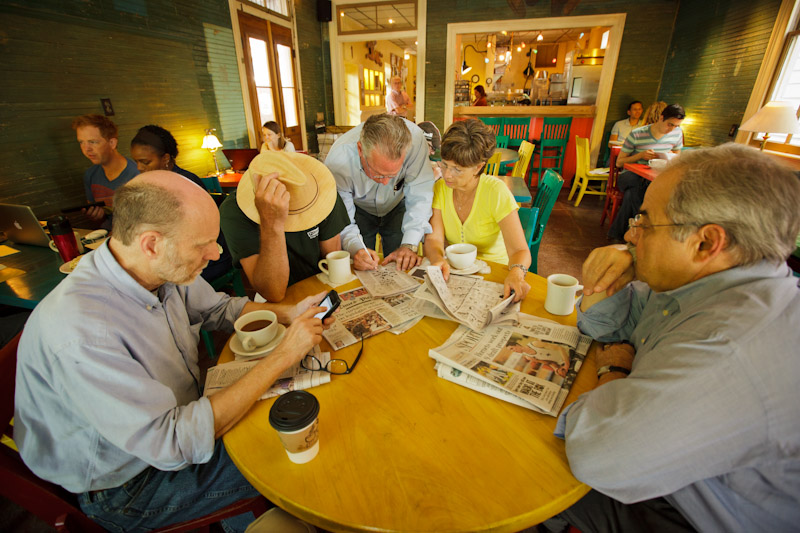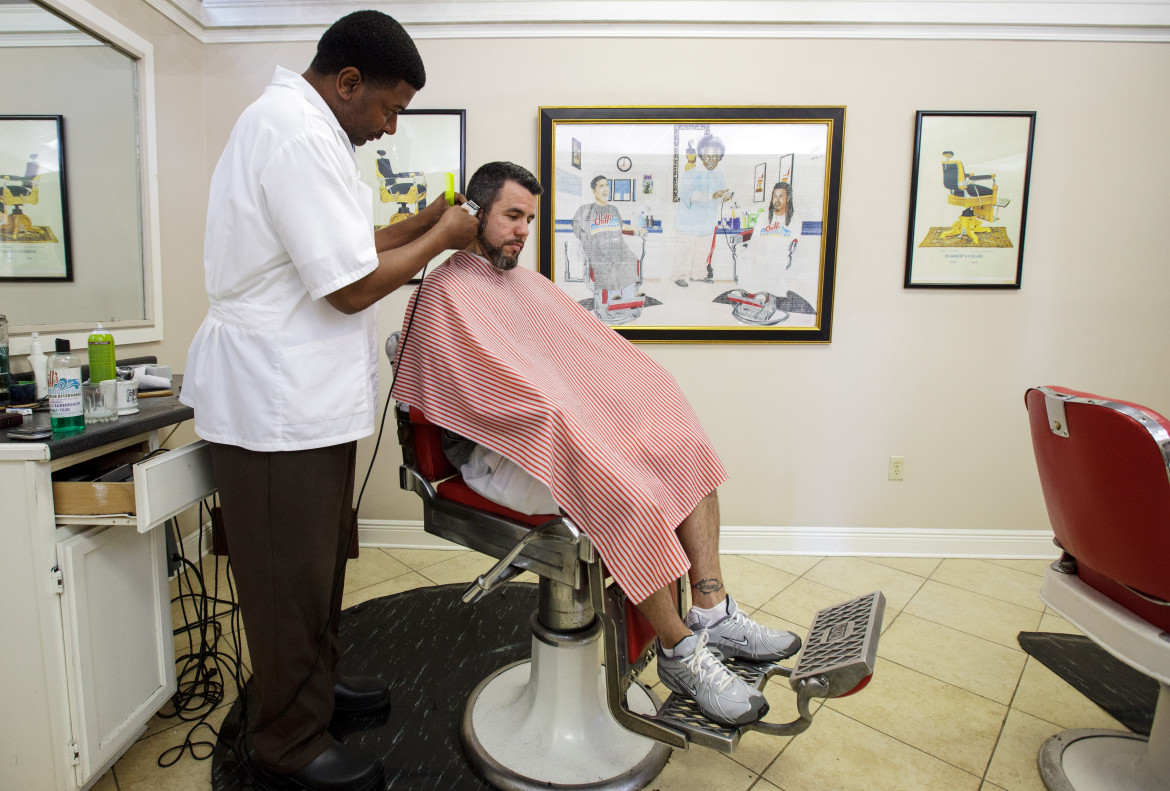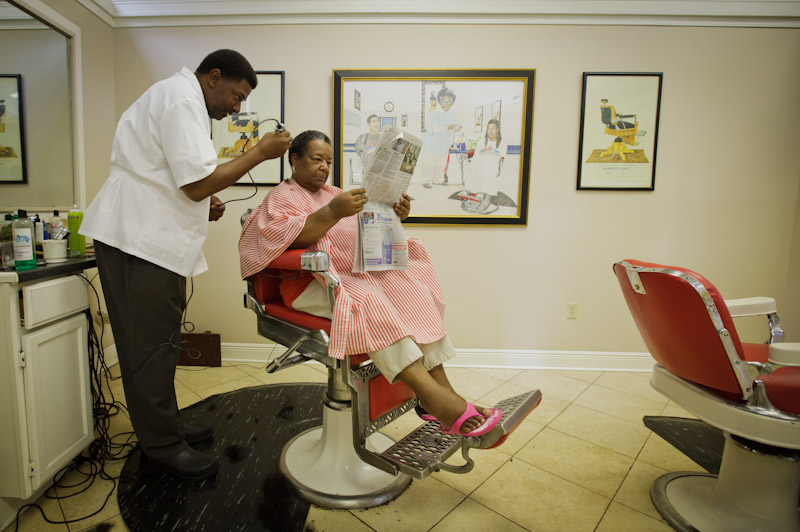A year ago today, news leaked that The Times-Picayune would cease daily publication, cut staff and focus on its website, NOLA.com. The paper and ink edition now hits doorsteps and newsstands just three days a week: Wednesday, Friday and Sunday.
History and tradition play an outsized role in New Orleans. So perhaps it is no surprise that The Times-Picayune’s move has led to a modern-day version of a relic of media history: the newspaper war.
The Advocate, which launched its daily New Orleans edition when the Picayune stopped its own, is now beefing up under a new local owner, John Georges. The Times-Picayune now plans a tabloid paper, TPStreet, for three days that it had abandoned.
Last year, photographer Bevil Knapp captured images of the daily newspaper ritual around New Orleans. This week I joined her to see how, nine months into this new era of news, people and communities are adapting. (In a separate post, Lens Managing Editor Steve Myers describes how The Lens fits into this new environment.)


These friends at the Fair Grinds coffee shop still meet to discuss politics, newspaper stories and each other, as they have for more than 20 years. But even on days The Times-Picayune is published, it’s no longer part of their routine.
“We’re so sad the paper decided to give up on us,” says nurse Sharon Morrow. “I’ve stopped my subscription. I mourn the paper almost every day.” Sections of The Advocate and The New York Times are strewn among the coffee cups instead. The group deems The Advocate’s New Orleans coverage not up to snuff, but Morrow says she hopes that will change “as they get to know our needs.”

New Orleans Radio for the Blind, 88.3 WRBH-FM, broadcasts a live reading of The Times-Picayune weekdays from 7 to 9 a.m.* Listeners were worried about what they’d hear on days the paper wasn’t printed, says production engineer Tim Vogel.
He used to cut out articles and hand them to the broadcasters. Now he copies text from NOLA.com in the early morning and sends it to tablets to be read on the air. “We’re actually more up to speed than the newspaper this way,” he says.



Master Barber Wilbert “Mr. Chill” Wilson still subscribes to The Times-Picayune and feels loyal to the paper. “Some of my customers don’t get the paper delivered to their houses, for financial reasons or they’re upset because of changes,” he says.
“That’s a nostalgic thing for a barber shop, to have a newspaper,” he says, but not on this Tuesday morning in his shop in Carrollton. He’s not seriously considered getting The Advocate.
Right now his customer is Carson Gauthreaux Jr., his fellow master barber. Normally, Gauthreaux says, he would be reading the paper right then, “waiting for my first customer” — but only if the Picayune came out that day.


Nuns need in-depth coverage of the city and the world, Sister Charlene Toups says, because “what is going on in the world informs your prayer.”
The monastery misses the daily paper. “I asked one sister, who does not use a computer, what she does on days there is no printed paper,” Toups says. “She told me: I read the old paper twice.”
They haven’t decided whether to get The Advocate; they will have to pray on that.

The Advocate says about 22,000 people buy its daily New Orleans edition. Michael Fitzpatrick now subscribes to The Advocate and The Times-Picayune. Like many New Orleans residents, he misses the daily death notices. “If someone you should know about has died, you have to wait to find out,” he says.
Fitzpatrick is eager to see what The Advocate does with its new owner and new talent. “I think the new owner is going to try to make it the paper of New Orleans. That’s what makes it exciting.”

Southern University at New Orleans criminologist professor John Penny also subscribes to both papers. He says a strong, daily printed newspaper creates an informed community, especially regarding public safety. “It’s kind of a map to direct you as to what your purpose is for that day.”
The Advocate does a good job of covering policy and happenings at the state level, he says, but it is not yet entrenched in the news of New Orleans. He hopes that void is filled as the newspapers begin to compete in earnest.
Eve Troeh is news director at WWNO, New Orleans Public Radio. She has reported and produced for various national public radio outlets, most recently as a staff reporter on the Sustainability Desk at APM’s Marketplace. Eve lived in New Orleans from 2000 to 2007 and reported on the city’s rebuilding after Hurricane Katrina. She’s happy to be back in town.
Bevil Knapp, a professional photographer for 27 years, has photographed Super Bowls, Sugar Bowls, presidents, governors, heads of state, Mother Teresa, Pope John Paul II, Noble Prize winners and music legends. These photos are copyrighted and available for sale on her website.
Editor’s note: This story is excluded from The Lens’ republishing arrangement.
*Correction: This post originally misstated the frequency of WRBH-FM, New Orleans Radio for the Blind. The station broadcasts at 88.3. (May 24, 2013)



Great photos, these.
By the time I actually stop getting the TP at home…. there will be nothing to miss.
Nobody can explain what makes NOLA NOLA, + intentional or not, we live on the extremes of worst of times, and best of times…
Yes they stole and gutted the Times Picayune, and continue to treat us like foolish lab rats, but one can give up the Dirty TP like cigarettes; it’s hard at first, but gets easier with time and the more others do the same.
+ The Lens, and hopefully Mr. Georges new brand of? are far healthier.
So if you still subscribe or click on any NOLA.scum- PLEASE PLEASE PLEASE (with powdered sugar on top) join the boycott and buy your news local.
Best from Freret,
Andy Brott
Give Georges a chance. He has already poached the top editors from the
Picayune and says he is wiling to finance The Nola Advocate (hmm, catchy
name John). He should consider a door-2-door residential campaign by
targeted zip code, seven days a week. He can base his zip code target on
advertising revenue from potential retailers and target 100,000 homes.
If he does this three weeks in a row he will establish the traditional
21-day reading habit. During the last week he should offer a new 3-month
subscription for $50. If my math (in my head) is correct, that’s a
potential $20,000,000 gross revenue stream from new subscriptions
alone. Take my advice John… and feel free to claim it as your
original idea. 🙂
Great!!!
Hope it works-
I love Mr. G’s changes so far, but there needs to be allot less LSU out of Swaggartsville to make it here.
+ BR still deserves their own.
So a year later- and we have 2 , but can 2 survive?
And Newhouse’s deep pockets don’t hear “noise”…
Time will tell- and maybe it’s Jim Amoss who will be the hero of record- as he seems to spend their cash to fail like a plot from Mel Brooks The Producers-
A tabloid called TP Street- HAHAHAHAHAAA….
It’s time for Rouses and others to do the right thing and “shop local”, before they get .
smeared…
AB
p.s + further proof on Zero Mostel theory-
http://nola.eater.com/archives/2013/05/21/nolacom-steals-nola-eats-moniker-from-blogger.php
The Dirty TP stole Leslie J. Almeida work…
NOLA.com is now far more aggressive in censoring conservative comments.
This will be bad as now, NOLA.com will only have viewers that are mostly left wing locals, if that. Will they buy a newspaper, yes? but not enough to sustain one newspaper much less two. One to three years from now who will be left in New Orleans anyway?
The older ones and the new young ones who just came in. The ones that came in after Hurricane Katrina have married and now have to get REAL JOB….and there is this Flood Insurance and taxes that will be far more than ever that need to paid….That means they LEFT LOUISIANA by now or soon.
These big plant deals outside of New Orleans, but in Louisiana, offer only a few hundred jobs at most. And Avondale leaving is already affecting schools like Xavier Prep (Avondale is a major employer of African Americans who can actually afford the Xavier Prep tuition. The alumni are overly optimistic to think they can actually make it work, if it does, there will be big changes, like co-ed, go after whites, kids in Nigeria, etc…) And the crime is front and center on the news, printed and web.
Companies, advertisers, were already leaving the T-P well before the Advocate entered the picture. And this is one of the big reasons the T-P went to 3 days a week; now back to a sort of 7 days a week. Once the printed goes away, what’s left? Internet and advertisers can far more accurately track their advertising dollar effectiveness on the internet.
One should ask themselves, “WHY advertise in the T-P or the Advocate Printed Edition?” The reach is now far far less, but more importantly, are these advertising dollars working? What do these printed advertising dollars have over the internet?
If 2 survive, IMO it will be Internet only. The NOLA locals are very poor to begin with, divorcies, fixed income,….New comers are already internet and will stay for a while and then get married and have to pay the bills…hence, goodbye nola, just like it has been for the last 50 years.
Results. On the local level the Internet can move cases but mass media moves truckloads.
The NOLA local level, resident and commercial, is SO POOR it generally can’t afford mass media…..Highest Poverty rate means something in advertising as it means less businesses that have enough revenue to PAY for advertising.
I have heard way too many stories of contractors getting STIFFED by local businesses and the other way around. Ask the contractor who did work for so and so, like a bar. It’s unbelievable how CHEAP those bars are.